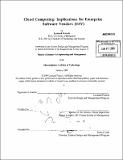Cloud computing : implications for enterprise software vendors (ESV)
Author(s)
Francis, Leonard, S.M. Massachusetts Institute of Technology
DownloadFull printable version (42.80Mb)
Alternative title
Implications for enterprise software vendors (ESV)
Other Contributors
System Design and Management Program.
Advisor
Michael A. M. Davies.
Terms of use
Metadata
Show full item recordAbstract
'Cloud computing', is a broad concept and in general is a term used for internet-based computing resources that are in an unspecified remote location or locations and that are flexible and fungible. Clouds provide a wide range of computing capability available as a service where users are separated from the underlying technology by a set of APIs. These computing capabilities are made available by abstracting at different levels; at the hardware level, development platform or the applications level. Cloud computing is particularly helpful to application developers and IT operations because it allows them to focus on the service/application provided rather than worrying about scaling, failure, maintenance or reliability of these computing resources. By consolidating and sharing computing resources among multiple tenants thus improving utilization, cloud computing brings cost savings to end users. The higher the abstraction level, greater are the benefits resulting from better resource utilization and thus more cost savings, both for providers and end users. As computing resources become cheaper, network connectivity and bandwidth improve both in terms of availability and pricing and human resources becomes expensive, cloud computing is increasingly seen as viable replacement of enterprise owned local IT infrastructure. (cont.) With the adoption of cloud computing comes a major shift in the underlying architecture of how we develop, deploy, deliver and run applications compared to existing behavior where we run applications on local computing resources and thus increasing pressure on enterprise software vendors to adopt these new business model for software development and new alternate software delivery models that are supported by and derive the benefits of cloud computing. While legacy enterprise software can simply be installed and run on instances on the cloud using cloud based infrastructure services, maximum benefits are realized by end users when these applications itself are provided as a service in the form of a platform or software. To do so, in most cases, legacy enterprise software would have to go through an architecture overhaul to be able to deliver existing functionalities as a platform or software as a service. Enterprise software vendors would also have to change their current business models where large license revenues, high maintenance cost of antiquated versions and heavily invested customers are the standard and move to pay-per-use cloud computing model. This thesis aims to study the implications of 'Cloud Computing' trends on the development, distribution, business models and the business of enterprise software vendors. This thesis tries to chart and predict the progress of trends in computing towards 'cloud computing', connect those trends to enterprise software usage changes and determine the impact on enterprise software vendors. (cont.) This will help enterprise software vendors to determine what if any strategic options available will help adopt this technological innovation and conform to future enterprise software requirements based on this trend.
Description
Thesis (S.M.)--Massachusetts Institute of Technology, System Design and Management Program, 2009. Includes bibliographical references (leaves 67-69).
Date issued
2009Department
System Design and Management Program.Publisher
Massachusetts Institute of Technology
Keywords
System Design and Management Program.